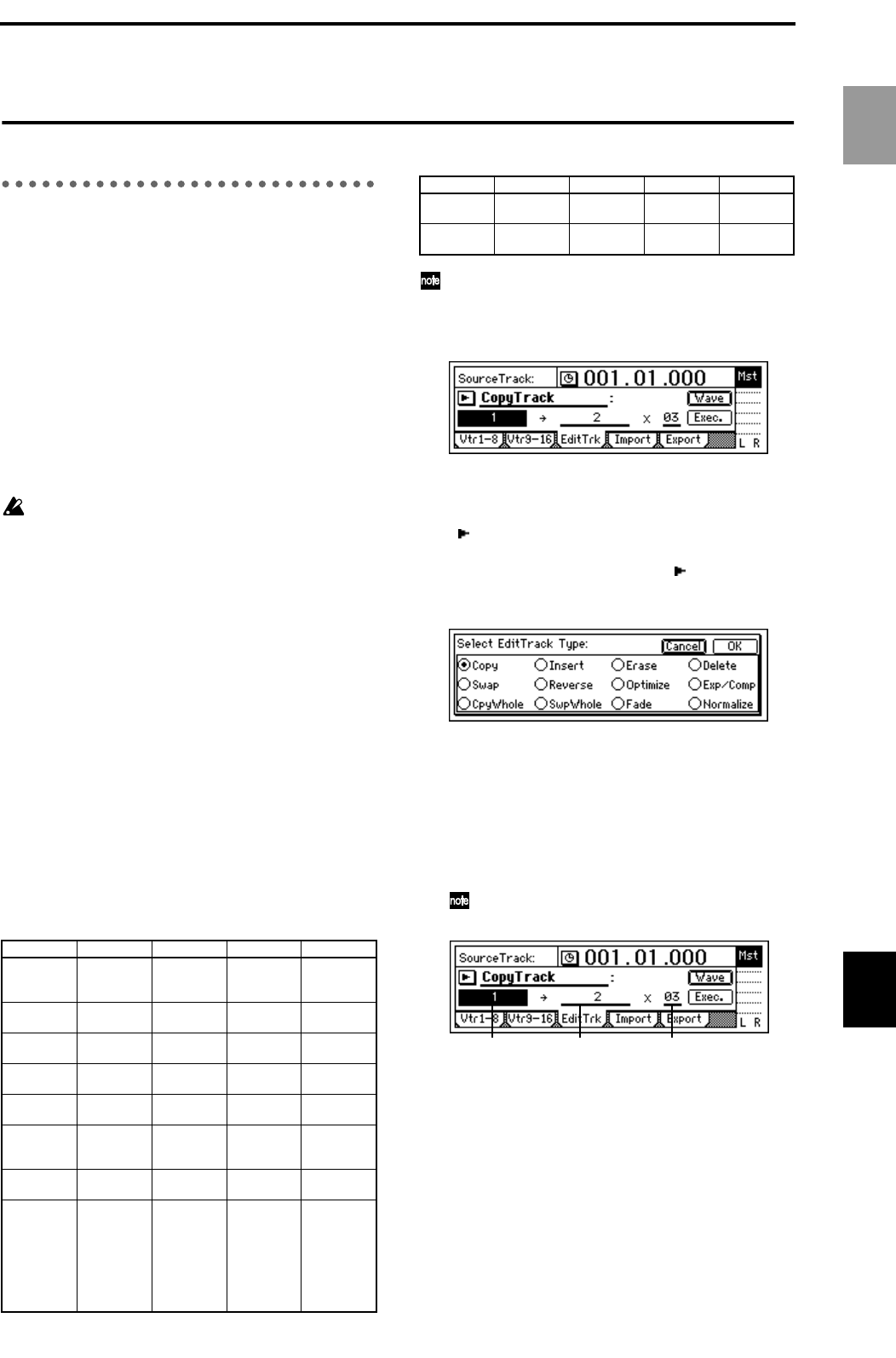
51
Step 10. Track editing
1. Track editing functions
The following functions are provided for track editing.
Copy Track: copy a track
Insert Track: insert a blank space
Erase Track: erase a track
Delete Track: delete a track
Reverse Track: reverses track audio end-to-end
Optimize Track: optimizes track data
Swap Track: exchange tracks
Expansion/Compression Track: expand or compress a
track
Copy Whole Track: copy an entire track
Swap Whole Track: exchange entire tracks
Fade Track: fade-in/fade-out
Normalize Track: optimize the level
In some cases, track editing functions may not be
usable if you have insufficient hard disk space. You
must allocate sufficient free space (equivalent to
the IN–OUT or TO–END time) for the track editing
operation.
Basic track editing procedure
1 Specify the region (time) that will be edited.
• In order to edit a track, you must first specify the
region (area of time) that will be edited.
• Move to the location that you wish to register.
• Press the [STORE] key, and then press one of the
following keys to register the corresponding
location.
[IN/LOC1] key: IN time
[OUT/LOC2] key: OUT time
[TO/LOC3] key: TO time
[END/LOC4] key: END time
The IN, OUT, TO, and END times are used as fol-
lows by each editing command.
How the editing commands use the IN, OUT, TO, and
END times
Depending on the “EditType,” the “Wave” button
may appear, allowing you to view the waveform as
you specify the location more precisely. (→p.82)
2 Access the [TRACK] “EditTrk” tab page.
3 Select the type of operation that you wish to exe-
cute (copy, insert blank, etc.).
Select “EditType.” Select the area to the right of the
“ ” button, and rotate the [VALUE] dial to select
the desired editing operation.
Alternatively, you can press the “ ” button to dis-
play “Select EditTrack Type,” and select the type of
editing.
4 Select the track(s) that you wish to edit.
The LCD screen will differ depending on the “Edit-
Type.” The screen shown in step 2 is when “Edit-
Type” is set to “CopyTrack.”
For “CopyTrack,” use “SourceTrack” to specify the
copy source track, “DestTrack” to specify the copy
destination track, and “Times” to specify the num-
ber of copies.
You can use “Wave” to view the waveform as
you specify the editing region.
5 Execute the selected track editing command.
Press the “Exec.” button to execute the selected
track editing command.
In the example shown in step 4, the data in the
IN–OUT region of track 1 will be copied three
times starting at the TO location of track 2.
IN OUT TO END
Copy Track Copy source
start time
Copy source
end time
Copy desti-
nation start
time
– – –
Insert Track Blank insert
start time
Blank insert
end time
– – –– – –
Erase Track Erase start
time
Erase end
time
– – –– – –
Delete Track Delete start
time
Delete end
time
– – –– – –
Swap Track Swap start
time
Swap end
time
– – –– – –
Reverse
Track
Reverse
start time
Reverse end
time
Reversed
copy destina-
tion start time
– – –
Optimize
Track
Optimize
start time
Optimize
end time
– – –– – –
Expansion/
Compres-
sion Track
Expand/com-
press start
time
Expand/com-
press end
time
Expand/com-
press desti-
nation start
time and
expand/com-
press result
copy destina-
tion start time
Expand/com-
press desti-
nation end
time
Fade Track Fade start
time
Fade end
time
– – –– – –
Normalize
Track
Normalize
start time
Normalize
end time
– – –– – –
IN OUT TO END
DestTrack TimesSourceTrack
Basic operation
Track editing


















